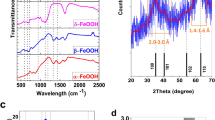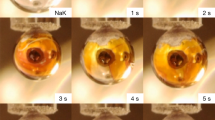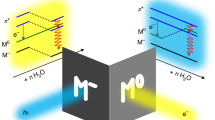Abstract
IT is known that quinhydrones are weak acids and may therefore form ions in strongly alkaline solutions. Due to the loss of two hydrogen atoms of the quinhydrone compound, two identical semiquinone ions can be expected; for example:  These semiquinone ions, having an odd number of electrons, should be paramagnetic. Michaelis has proved the existence of free radical ions of this type during alkaline reduction of phenanthrene-quinone-3-sulphonate1 by potentiometric and magnetic measurements. It would be difficult to demonstrate the existence of free radical ions in the case of many quinhydrones, for example, p-benzoquinhydrone, as they are too unstable in alkaline solution. It occurred to us, however, that it might be possible to stabilize such unstable radical ions by adsorption of quinhydrone on suitable basic surfaces. A sufficiently basic surface could have the same effect as the alkaline solution, and the adsorption might stabilize the free radicals formed.
These semiquinone ions, having an odd number of electrons, should be paramagnetic. Michaelis has proved the existence of free radical ions of this type during alkaline reduction of phenanthrene-quinone-3-sulphonate1 by potentiometric and magnetic measurements. It would be difficult to demonstrate the existence of free radical ions in the case of many quinhydrones, for example, p-benzoquinhydrone, as they are too unstable in alkaline solution. It occurred to us, however, that it might be possible to stabilize such unstable radical ions by adsorption of quinhydrone on suitable basic surfaces. A sufficiently basic surface could have the same effect as the alkaline solution, and the adsorption might stabilize the free radicals formed.
This is a preview of subscription content, access via your institution
Access options
Subscribe to this journal
Receive 51 print issues and online access
$199.00 per year
only $3.90 per issue
Buy this article
- Purchase on Springer Link
- Instant access to full article PDF
Prices may be subject to local taxes which are calculated during checkout
Similar content being viewed by others
References
Michaelis, L., Boeker, G. F., and Reber, R. K., J. Amer. Chem. Soc., 60, 202 (1938).
Bleaney, B., and Stevens, K. W. H., “Reports on Progress in Physics”, 16, 109 (1953).
Holden, A. N., Kittel, C., Merritt, F. R., and Yager, W. A., Phys. Rev., 77, 147 (1950).
See, for example, Wheland, G. W., “Advanced Organic Chemistry”, 54 (Wiley, New York, 1949).
Schoenberg, A., Mustafa, A., and Asker, W., J. Amer. Chem. Soc., 73, 2876 (1951).
Weitz, E., Schmidt, F., and Singer, J., Z. Electrochem., 46, 222 (1940). Weitz, E., and Schmidt, F., Ber., 72, 1740 (1939).
Goldschmidt, St., and Christmann, F., Ber., 57, 714 (1924).
Kaye, R. C., and Stonehill, H. I., J. Chem. Soc., 2636 (1951); 3231, 3240 (1952).
Author information
Authors and Affiliations
Rights and permissions
About this article
Cite this article
BIJL, D., KAINER, H. & ROSE-INNES, A. Stabilization of Free Radicals by Adsorption: Detection by Paramagnetic Resonance. Nature 174, 830–831 (1954). https://doi.org/10.1038/174830a0
Issue Date:
DOI: https://doi.org/10.1038/174830a0
This article is cited by
-
Protein quinone complexes. Bovine plasma albumin and halogenatedp-quinones
Journal of Bioenergetics and Biomembranes (1978)
-
Photochemical reaction of adsorbed anthraquinone with OH surface groups the effect of oxygen
Theoretical and Experimental Chemistry (1973)
-
Detection of Free Radicals in Sodium Dithionite by Paramagnetic Resonance
Nature (1956)
Comments
By submitting a comment you agree to abide by our Terms and Community Guidelines. If you find something abusive or that does not comply with our terms or guidelines please flag it as inappropriate.



